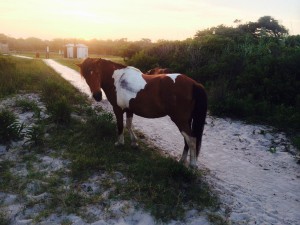
ASSATEAGUE — A wild horse on Assateague apparently struck by a vehicle last Thursday evening appears to be on the mend, but with the arrival of the holiday weekend and the height of the summer season the incident illustrates the importance of giving the island’s most famous inhabitants plenty of space and observing the traffic laws.
Sometime last Thursday evening, Assateague wild horse N6EM, or Maggie, is believed to have been struck by a vehicle on the barrier island and suffered an injury to her right front leg along with other injuries characterized as “road rash.” There were no witnesses and the driver did not report the incident, but the evidence is fairly clear Maggie was struck by a vehicle and injured.
“We assume she got hit by a vehicle,” said Assateague Island National Seashore Science Communicator Kelly Taylor. “No one witnessed it, but it’s a safe assumption based on the evidence and the horse’s condition. She was limping badly and had road rash and black markings on her side because the road in that area was recently paved.”
Taylor said a visitor to the island reported the injured horse to park rangers, who then found Maggie and assessed her condition to make sure she was okay.
“She was limping pretty badly on that first day, but within an hour or so after we first made contact with her, she was able to put weight on the injured front leg,” said Taylor. “By early this week, Maggie appeared to be moving along okay, but she is having trouble keeping up with her band. We saw her Tuesday morning and she still has a limp and is slightly lame, but we feel certain she is going to be okay.”
Taylor said Maggie appears to be on the mend but her recovery will take time.
“She is limping and in some pain, but that’s not necessarily a bad thing,” she said. “Just like humans, pain is a good thing because it tells us to slow down when we’ve been injured and it’s the same for a horse. The obvious difference is, Maggie can’t sit back and take it easy. She has to walk around to eat and drink and stay with her band.”
The incident serves as an important reminder for local residents and visitors to give the famed wild horses on Assateague their space and play close attention when the animals are out and about near the roads on the barrier island.
“The thing to consider when you’re around these horses is you have to think of them as little kids with a soccer ball,” said Taylor. “Kids chasing a ball will dart out into traffic and you have to drive as if that same thing can happen with these horses. They will often react in ways you wouldn’t expect.”
Assateague Island National Seashore Chief of Interpretation and Education Liz Davis agreed.
“The perception is these horses are tame because they’re very used to people, but they are wild animals and will act unpredictably at times,” she said. “A loud engine or even people’s voices will spook them and they will react like the wild animals they are. A horse with a fly or biting insect on its backside will buck or react in ways those observing them can’t predict.”
The Park Service has several safety reminders for visitors and residents regarding the horses mingling with vehicles. Drivers are reminded to be alert at all times on the barrier island, especially around the horses. Visitors are also reminded to not encourage the horses to come to their vehicles. The horses will sometimes approach vehicles and even stick their noses in car windows, but they are wild and often dangerous.
Not only is it unsafe for visitors to encourage the horses to come to their vehicles, it is also illegal. It is also dangerous for both the horses and the visitors. Since 1982, 29 wild horses on Assateague have been killed by vehicles. Thirteen others have been hit and survived, but suffered severe injuries.
Residents are urged to always obey the posted speed limits. However, when approaching horses in or on the side of the road, it may be necessary to drive even slower than the posted speed limit as common sense would dictate. Unfortunately, common sense, like horse sense, is often in short supply with vacationers interacting with wild animals on the barrier island.
“We can’t emphasize enough the importance of giving them their space,” said Taylor. “The law is 10 feet, but we encourage a bus length when possible. If a stallion began herding his mares away, or if a fight broke out or the horses got spooked, the question is could you stand where you are and not be at risk of getting run over? If the answer is no then you’re too close.”
In addition, Parks Service officials are taking the opportunity to warn residents and visitors not to feed or pet the wild horses, regardless of how tame or friendly they appear to be. Petting and feeding can cause harmful behavior changes in the horses. As they become more unafraid of humans, the horses can become more aggressive.
